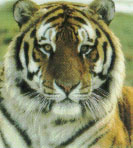

| Products | Jungle Gallery | Search | Y2K Information |
| Printers | Data Collection | Software | Point of Sale |
| Endangered List: Only 5,000 tigers remain to symbolize the last hope for their species survival. On the brink of extinction most subspecies of the tiger are already gone forever. |
 |
African Wild Cat Felis
lybica This is more than likely the most widely spread and most abundant of the cats in Africa. They are mainly nocturnal and are usually only seen well after sunset. Both male and female are highly territorial. The species in Southern Africa is under threat, due to inter-breeding with the domestic cat, reducing the gene pool of the wild cats. They will feed on mainly rodents, which would explain their successful distribution. They will also take birds, small mammals and reptiles. The female will give birth to about 3 kittens after a gestation period of 65 days. The young are usually born in holes dug out by other mammals, where available, although thickets of long grass, cracks in rocks and under bushes have been used for this purpose. LION Panthera leo Distribution: Northern Natal, Transvaal, Zimbabwe, Namibia and Mocambique. Diet: They will eat almost any kind of animal from insects to Elephants. Habitat: They are mainly found in woodland type areas but can survive in semi desert or bush areas. Habits:
|
|
Breeding:
Predators:
|
|
LEOPARD Panthera pardus Distribution: These cats can be found all over Southern Africa excepting in the O.F.S. and in the built up areas around Transvaal and the Cape. Diet: They will take a wide variety of prey from small to medium antelope, to beetles, fish and scavenging. Habitat: They are usually found in riverine bush but do have a very wide tolerance level for many different habitats. Habits:
Breeding:
Predators:
|
|
Cheetah Acinoyx jubatus Distribution: Zimbabwe, Mocambique, Botswana, Cape, and Namibia. Diet: Feed on a wide variety of animals from hares to the young of all ungulates, young of ostrich, small to medium sized antelope. Habitat: The cheetah is most commonly found in fairly open terrain but can be seen in thick bush as well as semi desert type situations. Habits:
Breeding:
Predators: The young are sometimes killed by Lion, hyena and Leopard. |